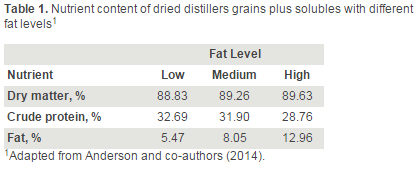Utilizing Reduced-Fat Distillers Grains in Beef Feedlot Rations

Changes at ethanol plants have reduced fat content in distillers grains, meaning feedlot rations will have to be altered.
By: Reid McDaniel, SDSU Extension Beef Feedlot Specialist
By now, most beef producers are familiar with corn distillers grains. This byproduct of the ethanol industry has found its way into all corners of the cattle-feeding world; from the cow/calf operation to the feedlot. Presently, some ethanol plants are using techniques to recover fat during the manufacturing process. This procedure decreases fat content of the byproduct from the typical range of 11 – 13% to as low as 4 – 5% on a dry matter basis (Table 1). The end product of fat removal can be either reduced-fat or low-fat distillers grains. The level of fat remaining in the byproduct is entirely dependent upon the mechanism of extraction.
Nutritional Implications
The advancements in fat removal technology may have important nutritional implications on the way distillers grains with solubles are fed. Since fat has 2.25 times the energy of starch, it is sensible to think that energy diminishes with fat removal. A trade-off for decreased fat is increased crude protein in the byproduct. Pritchard (2010) suggested that crude protein would be the largest contributor to the feeding value of reduced or low fat distillers byproducts. That being said, the question becomes how to use this new generation of byproducts and what are the implications of doing so?
Carcass Characteristics & Marbling
The majority of the published research is focused on utilizing full-fat distillers with limited information available relative to lower fat products. Depenbusch and co-authors (2008) fed steam-flaked corn-based diets containing either: 1) no dried distillers grains with solubles, 2) full-fat (12% fat) or 3) low-fat (4% fat) dried distillers grains with solubles. If dried distillers grains with solubles were included, it was at 13% of dietary dry matter. The authors reported similar performance and carcass characteristics in feedlot heifers. Anderson and Engel (2014) fed dry-rolled corn-based diets containing either: 1) no dried distillers grains with solubles, 2) low-fat (5.47% fat), 3) medium-fat (8.05% fat) or 4) high-fat (12.96% fat) dried distillers grains with solubles. If dried distillers grains with solubles were included, it was at 19.4% of dietary dry matter. The authors concluded that increased fat levels had minimal impact on feedlot performance but increased marbling scores of steers.
Feedlot Performance & Carcass Weights
Research from the University of Nebraska (Gigax and co-authors; 2011) reported greater final body weights and average daily gain in steers fed traditional wet distillers grains plus solubles (12.9% fat) compared to low-fat WDGS (6.7% fat) diets or no byproduct at all. Byproduct inclusion was at 35% of the dietary dry matter in dry-rolled and high-moisture corn-based diets. Feedlot performance did not differ between diets. Hot carcass weights were higher for steers fed the traditional product and no other carcass characteristics were impacted. Pritchard and co-authors (2012) evaluated the use of three ethanol byproducts with varying fat content in dry-rolled and high-moisture corn-based diets fed to feedlot steers. The authors concluded that increased dietary fat resulted in improved feedlot performance and heavier hot carcass weights.
Moving ahead, removal of corn oil from byproducts of ethanol production will continue. Research results have been variable relative to the impacts of fat removal from distillers grains on feedlot performance. Because of the indication that removing fat from ethanol byproducts impacts energy content of the feed, it may be best utilized as a protein source in feedlot rations.
More Information
For more in-depth discussion of feeding reduced-fat distillers grains to feedlot cattle, producers can contact Reid McDaniel at 605.688.5452.
References:
- Anderson, V. L., and C. L. Engel. 2014. Effects of fat level in distillers grain on feedlot finishing performance and carcass traits. North Dakota State University Beef Report AS1736-03.
- Depenbusch, B. E., E. R. Loe, M. J. Quinn, M. E. Corrigan, M. L. Gibson, K. K. Karges, and J. S. Drouillard. 2008. Corn distillers grains with solubles derived from a traditional or partial fractionation process: Growth performance and carcass characteristics of finishing feedlot heifers. J. Anim. Sci. 86: 2338-2343.
- Gigax, J. A., B. L. Nuttelman, W. A. Griffin, G. Erickson and T. Klopfenstein. 2011. Performance and carcass characteristics of finishing steers fed low-fat and normal-fat wet distillers grains. Nebraska Beef Cattle Report MP94:44-45.
- Pritchard, R. H. 2010. Use of de‐oiled dried distillers grains as a source of crude protein in finishing cattle diets. South Dakota








